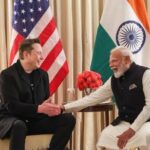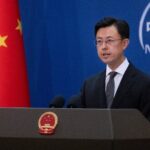Introduction
In a significant diplomatic development that underscores the growing strategic partnership between India and the United Arab Emirates (UAE), Sheikh Hamdan bin Mohammed bin Rashid Al Maktoum, the Crown Prince of Dubai, arrived in New Delhi on a high-profile two-day visit to India. The visit, which includes engagements in both the national capital and Mumbai, has been highlighted by Prime Minister Narendra Modi as a pivotal moment for strengthening bilateral collaboration between the two nations.
The Crown Prince’s visit comes amid an already robust diplomatic relationship between India and the UAE, which has seen remarkable growth in recent years across multiple sectors including trade, investment, energy, defense, and cultural exchanges. Prime Minister Modi’s enthusiastic reception of Sheikh Hamdan reflects the significance India places on its partnership with the UAE, which has emerged as one of India’s most important allies in the Middle East.
This article explores the details of the Crown Prince’s visit, the evolving India-UAE relationship, key areas of collaboration discussed during the meetings, and the potential long-term implications for both nations.
The Crown Prince’s Itinerary
Sheikh Hamdan bin Mohammed bin Rashid Al Maktoum’s visit to India follows a carefully structured itinerary spanning two major Indian cities. After arriving in New Delhi, the Crown Prince engaged in a series of high-level meetings with Indian government officials, including Prime Minister Narendra Modi and other key cabinet ministers responsible for commerce, external affairs, and infrastructure development.
The Delhi leg of his visit focused primarily on government-to-government discussions, strategic partnerships, and bilateral frameworks. Following the conclusion of his engagements in the national capital, the Crown Prince is scheduled to travel to Mumbai, India’s financial and commercial hub, where the focus is expected to shift toward business partnerships, investment opportunities, and economic collaboration.
In Mumbai, Sheikh Hamdan is likely to meet with leading Indian industrialists, financial institutions, and business leaders to explore enhanced commercial ties between Dubai and India. The two-city approach to the visit reflects a comprehensive engagement strategy that addresses both political and economic dimensions of the bilateral relationship.
Meeting with Prime Minister Modi
The highlight of the Crown Prince’s Delhi engagements was his meeting with Prime Minister Narendra Modi. The two leaders held extensive discussions on various aspects of bilateral cooperation, regional developments, and global issues of mutual interest.
Following their meeting, Prime Minister Modi took to social media to express his satisfaction with the discussions, stating: “The visit of His Highness Sheikh Hamdan bin Mohammed bin Rashid Al Maktoum to India paves the way for stronger bilateral collaboration between our nations. Our discussions focused on expanding the already robust partnership between India and the UAE across multiple sectors including trade, investment, technology, and culture.”
The Prime Minister further emphasized that India values its strategic partnership with the UAE and looks forward to working closely with Dubai under Sheikh Hamdan’s leadership to realize the full potential of bilateral relations. The warm reception extended to the Crown Prince, including ceremonial welcomes and cultural programs, highlighted the importance India attaches to this diplomatic engagement.
Key Areas of Bilateral Collaboration
During the Crown Prince’s visit, several key areas of bilateral collaboration were discussed and prioritized:
Trade and Investment
Trade relations between India and the UAE have flourished in recent years, with bilateral trade reaching approximately $85 billion annually. The UAE is currently India’s third-largest trading partner, while India ranks as one of the UAE’s primary trading partners. During the meetings, both sides expressed commitment to further expanding trade volumes and diversifying the trade basket.
Investment cooperation was another focal point, with discussions on streamlining processes for UAE investments in India and vice versa. The UAE has already committed substantial investments in India across various sectors including infrastructure, renewable energy, food processing, and technology. The Crown Prince’s visit is expected to accelerate investment flows in both directions.
Energy Partnership
Energy cooperation forms a crucial component of the India-UAE relationship. Traditionally centered around oil trade, the energy partnership has now expanded to include renewable energy, particularly solar power and green hydrogen. During the meetings, both sides explored opportunities for collaboration in energy transition projects, sustainable development initiatives, and climate action.
The UAE, as a major oil producer, remains an important energy security partner for India, which imports a significant portion of its crude oil requirements from the Gulf nation. Simultaneously, both countries are actively pursuing renewable energy goals, creating natural synergies for collaboration in this evolving sector.
Technology and Innovation
Digital transformation and technological innovation emerged as prominent themes during the discussions. Both India and the UAE have prioritized digital economies, artificial intelligence, fintech, and space technology in their national development strategies. The Crown Prince, known for his keen interest in technological advancement, engaged in detailed discussions about potential partnerships in these cutting-edge domains.
Specific initiatives discussed included cooperation in startup ecosystems, research and development collaborations between universities and technical institutions, and joint ventures in emerging technologies. The possibility of establishing innovation hubs connecting Dubai and major Indian technology centers was also explored.
Cultural and People-to-People Ties
The deep cultural and people-to-people connections between India and the UAE formed another important dimension of the discussions. With over 3.5 million Indians residing in the UAE, forming the largest expatriate community in the country, human connections serve as a strong foundation for bilateral relations.
During the visit, both sides emphasized the importance of cultural exchanges, tourism promotion, education partnerships, and healthcare collaboration. The facilitation of travel between the two countries, including visa procedures and air connectivity, was also addressed to further strengthen people-to-people ties.
Strategic and Defense Cooperation
Beyond economic and cultural ties, the visit also touched upon strategic and defense cooperation between India and the UAE. In recent years, the security partnership between the two nations has grown significantly, with regular joint military exercises, defense procurement discussions, and counterterrorism cooperation.
The geopolitical alignment between India and the UAE on regional issues, including shared perspectives on maintaining peace and stability in the Middle East and Indian Ocean region, has contributed to a deeper strategic understanding. During the Crown Prince’s visit, both sides reaffirmed their commitment to enhancing security cooperation and coordinating positions on regional and global challenges.
The Mumbai Agenda
Following his engagements in Delhi, Sheikh Hamdan’s schedule in Mumbai focuses predominantly on economic and business interactions. As India’s financial capital and home to its largest stock exchanges, leading banks, and corporate headquarters, Mumbai offers the ideal setting for discussions on investment, finance, and business partnerships.
The Crown Prince is expected to meet with prominent Indian business leaders, financial institutions, and industry associations during his Mumbai visit. Key sectors likely to feature in these discussions include:
- Financial Services: Exploring collaboration between Dubai International Financial Centre (DIFC) and Mumbai’s financial ecosystem.
- Real Estate and Infrastructure: Potential UAE investments in Indian infrastructure projects, smart cities, and real estate development.
- Entertainment and Media: Partnerships between Bollywood and Dubai’s growing entertainment sector.
- Maritime Cooperation: Enhancing connectivity between major ports in both countries and developing maritime logistics networks.
Several business forums and roundtable discussions have been organized to facilitate direct interactions between UAE investors and Indian business entities, potentially resulting in concrete agreements and memorandums of understanding.
The Comprehensive Economic Partnership Agreement (CEPA)
A significant backdrop to the Crown Prince’s visit is the Comprehensive Economic Partnership Agreement (CEPA) signed between India and the UAE in February 2022, which came into force in May of the same year. This landmark trade agreement aims to increase bilateral non-oil trade to $100 billion by 2030 and has already begun showing positive results.
During the current visit, both sides reviewed the implementation progress of CEPA and discussed ways to maximize its benefits. The agreement eliminates or reduces tariffs on a wide range of goods, liberalizes services trade, and creates mechanisms for investment promotion and protection.
The Crown Prince’s meetings in both Delhi and Mumbai included discussions on addressing implementation challenges, identifying new opportunities under the CEPA framework, and potentially expanding its scope to cover emerging areas such as digital trade and sustainability standards.
Regional and Global Context
The Crown Prince’s visit takes place against a complex regional and global backdrop. The Middle East continues to navigate geopolitical tensions, economic transformation challenges, and security concerns. Simultaneously, the global economic order is experiencing significant shifts due to trade tensions, supply chain realignments, and the growing focus on sustainable development.
In this context, the India-UAE partnership represents a model of constructive engagement that transcends traditional divides. Both countries have maintained balanced foreign policies, engaging with diverse global powers while prioritizing their national interests. The strengthening of this relationship sends a positive signal about the potential for productive cooperation in a multipolar world.
During the meetings, regional developments, including the situation in West Asia, were reportedly discussed, with both sides emphasizing the importance of dialogue, de-escalation, and diplomatic solutions to conflicts.
Business Community Response
The Indian business community has responded enthusiastically to the Crown Prince’s visit, viewing it as an opportunity to attract more investment from the UAE and expand their presence in Middle Eastern markets. Industry associations, including the Confederation of Indian Industry (CII) and the Federation of Indian Chambers of Commerce and Industry (FICCI), have actively participated in organizing business interactions during the visit.
Several Indian conglomerates with interests in the UAE have engaged directly with the Crown Prince’s delegation to discuss expansion plans, joint ventures, and strategic partnerships. Similarly, UAE-based business groups with existing or planned investments in India have used this opportunity to address regulatory issues, seek clarifications on policy matters, and explore new sectors for investment.
Future Outlook and Implications
The Crown Prince’s visit is expected to yield both immediate outcomes in the form of agreements and announcements, as well as long-term strategic directions for the bilateral relationship. Several key implications emerge from this diplomatic engagement:
Economic Diversification
For the UAE, deepening economic ties with India aligns perfectly with its economic diversification strategy aimed at reducing dependence on hydrocarbon revenues. India, with its large market, diverse economic sectors, and growing middle class, offers numerous opportunities for UAE investments beyond the traditional oil trade.
Simultaneously, for India, the UAE represents not only a source of investment but also a gateway to wider Middle Eastern, African, and European markets. The growing financial and logistics capabilities of Dubai and Abu Dhabi complement India’s manufacturing strengths and service sector expertise.
Geopolitical Alignment
The strengthening India-UAE partnership reflects a broader realignment in regional geopolitics, where both countries have found common ground on various international issues. This alignment extends to approaches toward terrorism, extremism, maritime security, and regional stability.
The relationship also demonstrates how countries with different political systems, cultural traditions, and developmental models can build productive partnerships based on mutual respect and shared interests. This aspect has particular significance in a world characterized by increasing polarization and bloc politics.
Innovation and Future Economy
Both India and the UAE have placed significant emphasis on future-oriented economic sectors, including renewable energy, artificial intelligence, space technology, and digital innovation. The Crown Prince’s visit has highlighted these complementary priorities and established frameworks for collaboration in these cutting-edge domains.
This focus on innovation could potentially lead to joint research initiatives, technology transfer arrangements, startup ecosystem linkages, and human capital development programs that benefit both nations in their journey toward knowledge-based economies.
Conclusion
Sheikh Hamdan bin Mohammed bin Rashid Al Maktoum’s visit to India marks another milestone in the rapidly evolving relationship between India and the UAE. Prime Minister Modi’s characterization of the visit as paving the way for “stronger bilateral collaboration” accurately captures its significance in the broader context of India’s engagement with the Middle East.
The comprehensive nature of the discussions—spanning trade, investment, energy, technology, culture, and strategic affairs—reflects the multidimensional character of the relationship. Moving beyond the traditional buyer-seller dynamic centered around oil trade, India and the UAE have established a genuine strategic partnership that addresses contemporary challenges and opportunities.
As the Crown Prince concludes his engagements in Delhi and proceeds to Mumbai, the outcomes of this visit will likely shape the trajectory of India-UAE relations for years to come. The implementation of agreements reached during these discussions, the follow-up mechanisms established, and the institutional frameworks strengthened will determine whether the ambitious vision articulated by the leadership of both countries translates into tangible benefits for their economies and peoples.
In an increasingly uncertain global environment, the India-UAE partnership stands out as an example of how nations can build bridges, create opportunities, and advance shared prosperity through diplomatic engagement and economic cooperation. The Crown Prince’s visit has certainly reinforced this positive trajectory and opened new avenues for collaboration between these two important regional powers.





